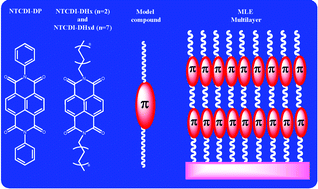The physical properties and finite size effects observed in 1,4;5,8-naphthalene-tetracarboxylicdiimide (NTCDI)-based organic multilayers assembled by molecular layer epitaxy (MLE) are investigated by structure–property studies of low molecular weight model compounds. These molecules, aliphatic N,N′-dihexyl-NTCDI (1), N,N′-dihexadecyl-NTCDI (2) and aromatic N,N′-diphenyl-NTCDI (3), mimic the elemental building blocks of the solid-state heterostructures, NTCDI-based organic superlattices. Thermal analysis combined with polarized optical microscopy reveals that both 1 and 2 have polymorphic phases at an elevated temperature range. All model compounds show new absorption (abs.) and photoluminescence (PL) bathochromically shifted bands in concentrated (mM) solutions, as is also seen in MLE-derived organic superlattices. The strong tendency to aggregate and the photophysical properties of the model compounds are correlated with the PL and electrical field dependent electroluminescence (EL). This clarifies the structure-tunable emission by virtue of in-plane excitons in solid-state MLE structures. Finally, X-ray diffraction of single crystals of 1 and 3 reveal similar packing motifs for the molecules and the resulting solid-state MLE heterostructures.

You have access to this article
 Please wait while we load your content...
Something went wrong. Try again?
Please wait while we load your content...
Something went wrong. Try again?


 Please wait while we load your content...
Please wait while we load your content...